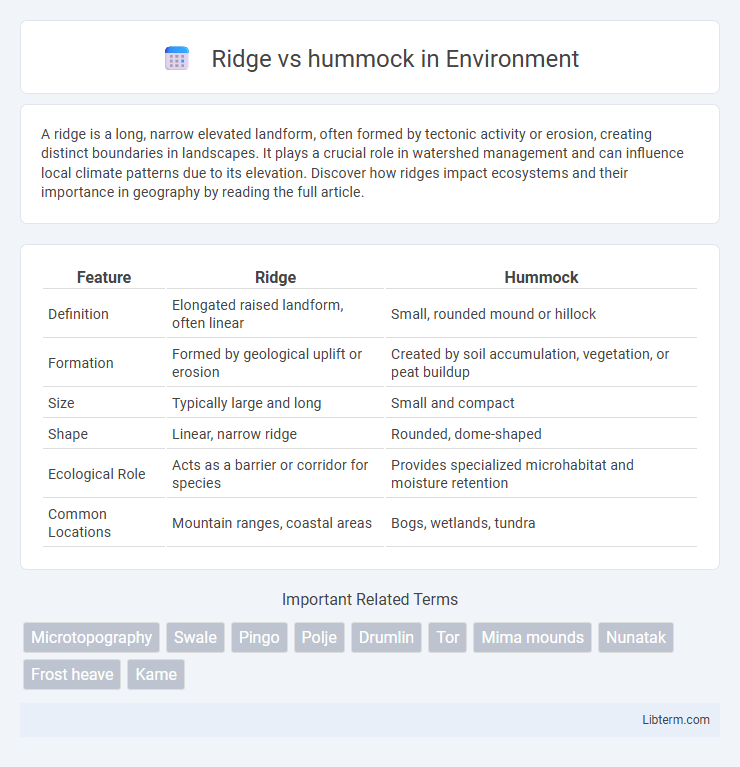A ridge is a long, narrow elevated landform, often formed by tectonic activity or erosion, creating distinct boundaries in landscapes. It plays a crucial role in watershed management and can influence local climate patterns due to its elevation. Discover how ridges impact ecosystems and their importance in geography by reading the full article.
Table of Comparison
| Feature | Ridge | Hummock |
|---|---|---|
| Definition | Elongated raised landform, often linear | Small, rounded mound or hillock |
| Formation | Formed by geological uplift or erosion | Created by soil accumulation, vegetation, or peat buildup |
| Size | Typically large and long | Small and compact |
| Shape | Linear, narrow ridge | Rounded, dome-shaped |
| Ecological Role | Acts as a barrier or corridor for species | Provides specialized microhabitat and moisture retention |
| Common Locations | Mountain ranges, coastal areas | Bogs, wetlands, tundra |
Introduction to Ridge and Hummock
A ridge is an elongated, raised landform often formed by tectonic activity or erosion, characterized by a continuous crest and steep slopes. Hummocks are smaller, rounded mounds or knolls typically resulting from soil movement or deposition processes, such as frost heaving or volcanic activity. Both ridges and hummocks influence local drainage patterns and ecosystem distribution due to their distinct topographical features.
Defining Ridges: Key Characteristics
Ridges are elongated raised landforms characterized by continuous elevated crests and steep slopes on either side, often formed by tectonic activity or erosion processes. Their linear shape distinguishes them from isolated mounds like hummocks, with lengths that can span several kilometers and elevations varying significantly depending on geological context. Ridges commonly serve as watershed divides and influence local climate patterns due to their height and orientation.
Understanding Hummocks: Core Features
Hummocks are small, rounded mounds typically formed by the accumulation of organic material or frozen ground processes, often measuring less than a meter in height. They differ from ridges, which are elongated, linear landforms primarily created by tectonic or erosional forces. Understanding hummocks' core features--such as their irregular shape, variable size, and common presence in permafrost regions--provides insight into their ecological role and formation mechanisms.
Formation Processes of Ridges
Ridges form through tectonic plate interactions such as folding, faulting, and volcanic activity, creating elongated raised landforms often found at convergent or divergent boundaries. These geological processes involve intense pressure and upward displacement of rock layers, contributing to structural elevation over surrounding terrain. Unlike hummocks, which result from localized soil or debris accumulation, ridges reflect broader-scale crustal deformation and uplift mechanisms.
How Hummocks Are Formed
Hummocks are formed through the accumulation of ice and snow that creates small, mound-like features often found in permafrost or glaciated regions. Unlike ridges, which are elongated elevated landforms shaped by tectonic activity or erosion, hummocks result from the uneven thawing and freezing of soil or ice beneath the surface. This freeze-thaw cycle leads to the uplifting and displacement of sediment, forming irregular, rounded mounds distinct from the linear structure of ridges.
Ridge vs Hummock: Geological Differences
Ridges are elongated, raised landforms formed primarily by tectonic plate movements or volcanic activity, often characterized by steep slopes and linear orientation. Hummocks are small, rounded mounds created by soil heaving, frost action, or sediment accumulation, typically irregular in shape and smaller in scale compared to ridges. Geological differences between ridges and hummocks lie in their formation mechanisms, morphology, and spatial extent in the landscape.
Ecological Significance of Ridges and Hummocks
Ridges and hummocks create diverse microhabitats that influence soil moisture, temperature, and nutrient availability, supporting varied plant and animal communities. Ridges often promote better drainage and aeration, favoring species adapted to drier conditions, while hummocks collect water and organic matter, providing refuge for moisture-loving vegetation and microorganisms. This spatial heterogeneity enhances ecosystem resilience, biodiversity, and nutrient cycling within wetland and forested landscapes.
Common Locations and Examples
Ridges commonly form in mountainous regions such as the Appalachian Mountains in the United States and the Andes in South America, characterized by elongated elevations with steep sides. Hummocks are frequently found in tundra and glaciated landscapes, like those seen in the Arctic tundra and parts of Alaska, consisting of small, rounded mounds of earth or ice. Both landforms appear in diverse environments but differ in scale and formation, with ridges representing larger, linear high points and hummocks representing smaller, irregular mounds.
Ridge and Hummock: Impacts on Landscape
Ridges create elevated linear landforms that influence water drainage patterns, soil erosion, and microclimates by directing wind and water flows, often resulting in distinct vegetation zones. Hummocks are small, rounded mounds that modify surface roughness and soil moisture distribution, supporting unique habitats and increasing landscape heterogeneity. Both features shape ecological processes by altering topography, impacting biodiversity, and affecting sediment deposition within terrestrial ecosystems.
Summary: Choosing Between Ridge and Hummock
Ridges are elongated, raised landforms typically formed by tectonic or glacial activity, offering stability and larger surface area for construction or ecosystems. Hummocks are smaller, rounded mounds often created by frost heave or sediment deposition, providing localized elevation with less structural stability. Choosing between ridge and hummock depends on the scale of the project, soil stability, and environmental impact considerations.
Ridge Infographic

 libterm.com
libterm.com